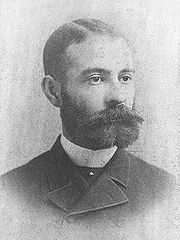BLACK SOCIAL HISTORY
Daniel Hale Williams
| Dr. Daniel Hale Williams | |
|---|---|
 | |
| Born | January 18, 1856 Hollidaysburg, Pennsylvania,USA |
| Died | August 4, 1931 (aged 75) Idlewild, Michigan, USA |
| Fields | Cardiology |
| Institutions | Provident Hospital Meharry Medical College Freedman's Hospital St. Lukes Hospital Cook County Hospital |
| Alma mater | Chicago Medical College |
Daniel Hale Williams (January 18, 1856[1] – August 4, 1931) was an African-American general surgeon who, in 1893, performed the second documented successful pericardium surgery to repair a wound.[2][3][4][5] He also founded Provident Hospital, the first non-segregated hospital in the United States.[6]
Career
At the time that he graduated from medical school, black doctors were not allowed to work in Chicago hospitals. As a result, in 1891, Williams started the Provident Hospital (Chicago) and training school for nurses in Chicago, Illinois. This was established mostly for African-American citizens.[7]
In 1893, Williams became the second surgeon on record to have successfully performed pericardium surgery to repair a wound,Henry Dalton was the first. On September 6, 1891,[3][4] Dalton successfully performed pericardium surgery a repair a wound with the patient fully recovering.[8] Earlier successful surgeries to drain the pericardium, by performing a pericardiostomy were done byFrancisco Romero in 1801[9] and Dominique Jean Larrey in 1810.[10]
On July 10, 1893, Williams repaired the torn pericardium of a knife wound patient, James Cornish.[3] Cornish, who was stabbed directly through the left fifth costal cartilage,[3] had been admitted the previous night and Williams made the decision to operate the next morning in response to continued bleeding, cough and "pronounced" symptoms of shock.[3] He performed this surgery, without the benefit of penicillin or blood transfusion, at Provident Hospital, Chicago,[11]though it would not be reported until 1897.[3] About fifty-five days later, James Cornish had successfully recovered from the surgery.[7] In 1893, during the administration of President Grover Cleveland, Williams was appointed surgeon-in-chief of Freedman's Hospital in Washington, D.C., a post he held until 1898 when he married and moved to Chicago. In addition to organizing the hospital, Williams also established a training school for African-American nurses at the facility.
Williams was a teacher of Clinical Surgery at Meharry Medical College in Nashville, Tennessee and was an attending surgeon at Cook County Hospital in Chicago. He worked to create more hospitals with accessibility to African Americans. In 1895 he co-founded the National Medical Association for African American doctors, and in 1913 he became a charter member and the only African American doctor in the American College of Surgeons.
Personal life
Daniel Hale Williams was born and raised in the city of Hollidaysburg, Pennsylvania. His father, Daniel Hale Williams, Jr. was the son of a black barber and a Scots-Irishwoman.[12]
He lived with his father who was a "free negro" barber, his mother, his brother and five sisters and was the fifth child of the family. His family eventually moved to Annapolis, Maryland. Shortly after when Williams was nine, his father died of tuberculosis.[13] Williams' mother realized she could not manage the entire family and sent some of the children to live with relatives. Williams was apprenticed to a shoemaker in Baltimore, Maryland but ran away to join his mother who had moved to Rockford, Illinois. He later moved toEdgerton, Wisconsin, where he joined his sister and opened his own barber shop. After moving to nearby Janesville, Wisconsin, Williams became fascinated with a local physician and decided to follow his path. He began working as an apprentice to Dr. Henry W. Palmer for two years and in 1880 entered Chicago Medical College, now known asNorthwestern University Medical School. After graduation from Northwestern in 1883, he opened his own medical office in Chicago, Illinois.[14]
Williams was married in 1898 to Alice Johnson, daughter of sculptor Moses Jacob Ezekiel and a maid of mixed ancestry.[15] Williams died of a stroke in Idlewild,Michigan on August 4, 1931. His wife, Alice Johnson, had died in 1924.[7]
Legacy
In the mid-1890s, attempts were made to improve cardiac surgery. The first successful surgery on the heart itself was performed by Norwegian surgeon Axel Cappelen on 4 September 1895 at Rikshospitalet in Kristiania, now Oslo.[16][17] The first successful surgery of the heart, performed without any complications, was by Dr. Ludwig Rehn ofFrankfurt, Germany, who repaired a stab wound to the right ventricle on September 7, 1896.[18][19] Despite these improvements, heart-related surgery would not be widely accepted in the field of medical science until World War II broke out and forced surgeons to improve their methods of surgery in order to repair severe war wounds.[20] In spite of the early lack of recognition they received for their surgeries, Dalton and Williams would later receive recognition for their roles in pioneering cardiac surgery.[20]
The Stevie Wonder song "Black Man" honors the achievements of Williams, among others.
Tim Reid Plays Dr. Williams in Sister, Sister (TV series) season 5 episode 18 "I Have a Dream" (February 25, 1998)
In 2002, scholar Molefi Kete Asante listed Daniel Hale Williams on his list of 100 Greatest African Americans.[21]
He received honorary degrees from Howard and Wilberforce Universities, was named a charter member of the American College of Surgeons and was a member of the Chicago Surgical Society.
A Pennsylvania State Historical Marker was placed at U.S. Route 22 eastbound (Blair St., 300 block), Hollidaysburg, Pennsylvania commemorating his accomplishments and marking his boyhood home.[22]

































































































No comments:
Post a Comment